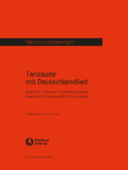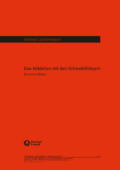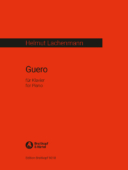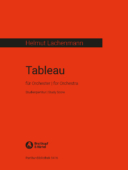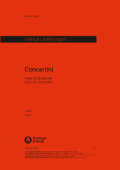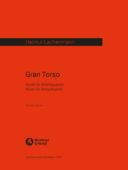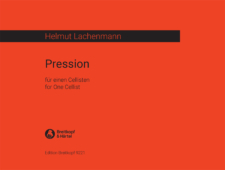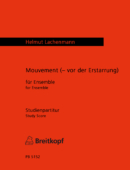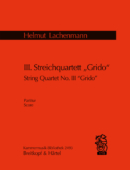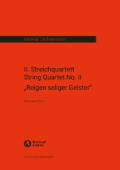Helmut Lachenmann – 90. Geburtstag 2025
Ein besonderes Jahr für einen großen Komponisten
Helmut Lachenmann zählt zu den einflussreichsten Komponisten der Gegenwart, der maßgeblich zur Entwicklung der postseriellen Musik beigetragen und ihr neue Wege des kompositorischen Denkens eröffnet hat. Mit seinem kompositorischen Ansatz, den er selbst als „musique concrète instrumentale“ bezeichnet, hat er die klanglichen Möglichkeiten des traditionellen Instrumentariums radikal erweitert. Geräusche, Reibungen und die physischen Klangerzeugungsprozesse selbst werden in seinen Werken nicht nur hörbar gemacht, sondern zum eigentlichen Gegenstand der Komposition. Lachenmanns Musik verweigert sich jeder Form klanglicher Konvention und wird so zur Schule des Hörens – für Musiker wie für Publikum.
Geboren 1935 in Stuttgart, studierte er von 1955 bis 1958 bei Johan Nepomuk David Theorie und Kontrapunkt sowie Klavier bei Jürgen Uhde. Eine prägende Erfahrung für seine kompositorische Ästhetik war die Begegnung mit Luigi Nono während der Darmstädter Ferienkurse 1957, wo er ab 1972 selbst unterrichtete. Von 1958 bis 1960 war er Privatschüler von Nono in Venedig. Nono verstand Musik als ein Werkzeug, gesellschaftliche und politische Kontexte in kunstvoller Weise sichtbar zu machen, was Lachenmann dazu anregte, derartige Themen in seinen eigenen Werken zu reflektieren. Zudem beeinflusste Nono Lachenmanns Herangehensweise an den Klang selbst, indem er ihn, unkonventionelle Techniken und Geräusche in seine Kompositionen einzubeziehen.
Mitte der 60er Jahre begegnete Lachenmann, erneut in Darmstadt, mit Olivier Messiaen noch einem weiteren Komponisten, der einen bedeutenden Einfluss auf die Entwicklung seiner Klangsprache hatte.
Anschließend lebte Lachenmann bis 1973 als freischaffender Pianist und Komponist in München, bevor er Professuren in Hannover (ab 1976) und von 1981 bis 1999 in Stuttgart übernahm.
Als reflektierter Künstler hat Lachenmann zahlreiche Texte verfasst, die das Verhältnis zwischen musikalischer Kunst und Gesellschaft thematisieren. Zu seinen bedeutenden Schriften zählen „Musik als existentielle Erfahrung“ (1996) und „Kunst als vom Geist beherrschte Magie“ (2021).
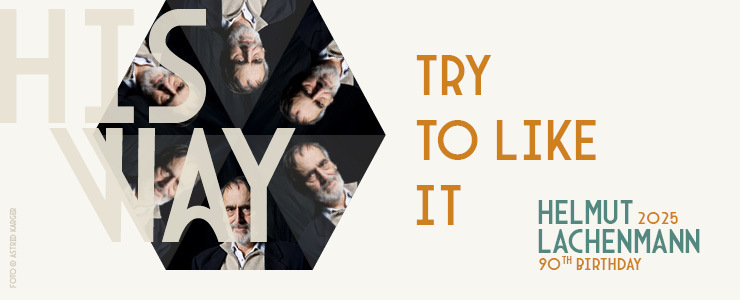
Die sechs Elemente des „Lachenmann-Kaleidoskops“
Helmut Lachenmann hat die heutige Musikwelt durch seine innovativen Ansätze und Konzepte nachhaltig geprägt. Während andere zeitgenössische Komponisten sich von bestehenden Traditionen und Strömungen beeinflussen ließen, verfolgte Lachenmann stets seinen eigenen Weg, hinterfragte aktiv bestehende Konventionen und definierte sie neu.
Die Musik Lachenmanns ist durch verschiedene Charakteristika geprägt, die entweder gleichzeitig oder auch nur in Teilen ihren Einfluss auf den klanglichen Ausdruck haben – vergleichbar mit dem Blick durch ein Kaleidoskop, der auch unterschiedliche Aspekte des fokussierten Motivs freizulegen vermag.
Klangexperimente und die Materialität des Hörens
Lachenmanns Musik ist geprägt von einer Erforschung des Klangs in seiner physischen Entstehung. Wo traditionelle Instrumentalmusik auf Melodie, Harmonie und Rhythmus aufbaut, interessiert sich Lachenmann für die Materialität des Klangprozesses – das Kratzen des Bogens auf der Saite, das Reiben der Finger auf Holz oder Metall, den hörbaren Atem der Bläser. Sein Orchesterwerk „Schwankungen am Rand“ (1974–75) ist ein paradigmatisches Beispiel für diese Klangforschung: Die Musiker sind angehalten, ihre Instrumente in unkonventionellen Techniken zu spielen, wodurch eine völlig neue akustische Welt entsteht. Ähnlich erforscht „Pression“ (1969) für Violoncello solo die klanglichen Möglichkeiten des Instruments jenseits klassischer Tonerzeugung.
In „Gran Torso“ (1971) für Streichquartett werden die vier Instrumente nicht als Träger harmonischer Verläufe behandelt, sondern als Geräuschquellen, deren Saiten gekratzt, gestrichen und angeschlagen werden. Diese radikale Erweiterung der Spieltechniken hat die Aufführungspraxis für Streichquartette nachhaltig beeinflusst.
Stille als kompositorisches Element
Ein zentrales Merkmal in Lachenmanns Musik ist der bewusste Einsatz von Stille als Teil der Komposition. Stille ist bei ihm kein bloßer Pausenraum, sondern eine akustische Spannung, die das Zuhören neu definiert. In seinem Werk „… Zwei Gefühle …“ (1991–92) für Sprecher und Ensemble wird das Wechselspiel zwischen Klang und Stille gezielt als dramaturgisches Mittel eingesetzt: Die Musik bricht ab, setzt neu an, hält inne – ein Dialog zwischen Klang und Stille, der das Publikum auf subtile Weise herausfordert.
Ein weiteres Beispiel ist „Guero“ (1970) für Klavier, in dem Lachenmann fast vollständig auf die traditionelle Tonerzeugung verzichtet. Stattdessen erkundet der Pianist die mechanischen Geräusche des Instruments: Streichen über die Tasten, das Reiben über die Saiten, das Klopfen auf Holz und Metall. Die Stille zwischen diesen Aktionen wird ebenso Teil der Komposition wie die Klänge selbst.
Ästhetischer Widerstand – Musik als Haltung
Lachenmanns Musik ist untrennbar mit dem Begriff „ästhetischer Widerstand“ verbunden, den er selbst geprägt hat. Dieser Widerstand richtet sich gegen die ästhetische Gewohnheit – gegen eine Musik, die sich dem Hörer anbiedert, statt ihn zu fordern. In „Accanto“ (1975–76) für Klarinette und Orchester wird diese Haltung besonders deutlich: Während das Soloinstrument an klassische Konzerttraditionen erinnert, wird sein Klang von einem Orchester aus Geräuschen, Reibungen und unorthodoxen Klangerzeugungen konterkariert. Das Werk verweigert sich einer einfachen Schönheit und fordert eine aktive Auseinandersetzung mit dem Hören.
Ein weiteres Beispiel für diesen Widerstand ist „Mouvement (– vor der Erstarrung)“ (1982–84) für Ensemble, in dem musikalische Gesten immer wieder ins Leere laufen, auseinanderbrechen und neu zusammengesetzt werden. Nichts entwickelt sich nach konventioneller Logik, alles bleibt im Fluss – eine Musik der Unruhe und des Widerstands gegen festgefügte Formen.
Intermedialität und performative Erweiterung
Lachenmanns Werke überschreiten oft die Grenzen zwischen Musik, Sprache und Theater. In seiner Musiktheater-Komposition „Das Mädchen mit den Schwefelhölzern“ (1990–96) verbindet er Textfragmente von Hans Christian Andersen, Gudrun Ensslin und Leonardo da Vinci mit einer innovativen Klangsprache. Hier wird die körperliche Präsenz der Musiker zum integralen Bestandteil des Ausdrucks: Geräusche entstehen nicht nur durch Instrumente, sondern auch durch Stimme, Bewegung und Aktion.
Auch „Kontrakadenz“ (1970–71) für großes Orchester arbeitet mit einer fast szenischen Anlage: Das Verhältnis zwischen Klang, Aktion und Aufführungsraum wird bewusst in Frage gestellt, die Musik erscheint nicht als abgeschlossenes Werk, sondern als ein sich ständig wandelnder Prozess.
Avantgarde und Dekonstruktion
Lachenmanns Musik ist kein postmodernes Spiel mit Zitaten, sondern eine konsequente Dekonstruktion musikalischer Traditionen. In „Toccatina“ (1986) für Violine solo werden klassische Spieltechniken nicht übernommen, sondern in ihre Einzelteile zerlegt und neu zusammengesetzt. Die Geige erklingt nicht in virtuoser Brillanz, sondern in einer Vielfalt von Geräuschklängen, die die Grenzen des Instruments ausloten.
Ein weiteres Beispiel für diese Dekonstruktion ist „Serynade“ (1997–98) für Klavier, ein Werk, das den herkömmlichen Klaviersatz aufbricht und den Klangraum des Instruments auf ungewöhnliche Weise erforscht.
Helmut Lachenmann bei Breitkopf & Härtel
Die Beziehung Breitkopf & Härtel und Helmut Lachenmann nahm 1980 ihren Anfang, als der Verlag den Kölner Gerig-Verlag und mit ihm die durch ihn vertretenen Komponisten zeitgenössischer Musik übernahm, zu denen auch Helmut Lachenmann zählte. Damit war für Breitkopf & Härtel der Grundstock seines innovativen zeitgenössischen Programms gelegt, an dessen Weiterentwicklung und Profilierung die Werke Lachenmanns über die nachfolgenden Jahre hinweg einen maßgeblichen Anteil hatten.
Heute finden sich die wesentlichen Werke Lachenmanns, von seinen Kammermusik- und Solowerken bis hin zu den großformatigen Orchesterkompositionen, im Verlagskatalog von Breitkopf & Härtel.










